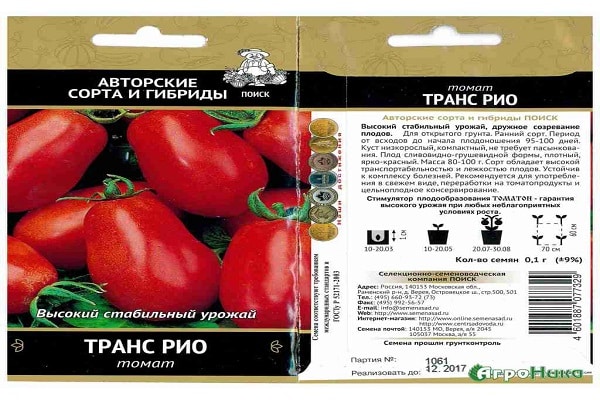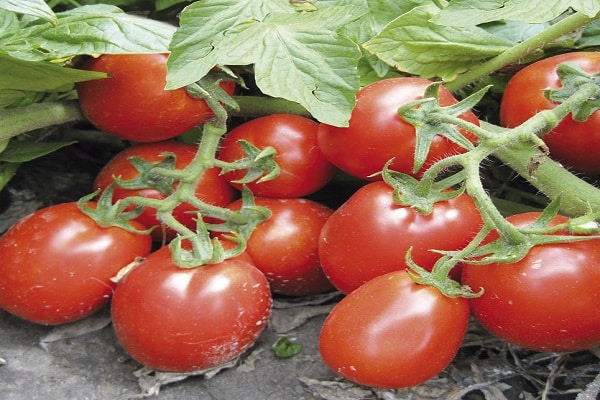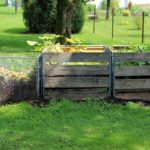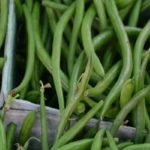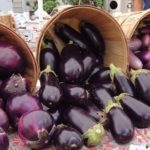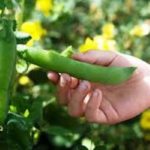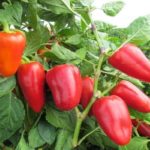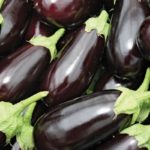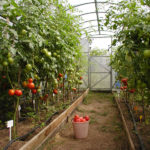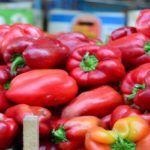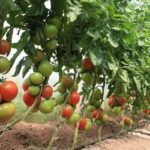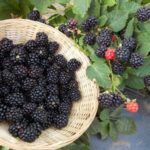Intended for growing in open areas, the Trans Rio tomato is already in demand among sellers who do not have the opportunity to install a greenhouse on the site. The variety has a number of positive characteristics, such as the appearance of the fruit and ease of cultivation. Let's consider the description of the variety and methods of growing bushes on the site.
Description of the variety
The variety is determinate, intended for cultivation in open ground. Early ripening, low growing bush. It takes about 100 days from seed germination to the first ripe tomatoes.The growth of the bush and root system is average, the number of leaves is moderate. When grown, it does not require special care, such as gartering and pinching.
The bush does not grow higher than 45 centimeters in height, but if the fruits are heavy, lodging is possible, so experts recommend tying the bushes to a support. The yield is high; on average, up to 15 kilograms of fruit are harvested per square meter. In this case, 5–6 bushes are planted per square meter. The variety is resistant to many dangerous diseases, such as fusarium, crown and root rot, and verticillium.
The fruits are of medium size - the weight of one vegetable is 80–100 grams. The shape is pear-shaped or plum-shaped. The color is red; when ripe, there is no brown spot near the stalk. A tomato of medium juiciness, sweet and sour. Intended for fresh consumption and pickling.
Positive qualities of the bush and fruits
During cultivation, gardeners noted the following positive characteristics.
- High yield.
- High quality and tasty fruits.
- The variety is resistant to diseases.
- Suitable for growing on an industrial scale.
- The bushes do not require pinching.
- Fruits well in an open garden.
Agrotechnics of cultivation
Trans Rio tomatoes are mainly grown in seedlings. Seeds are planted in the ground 60 days before the bushes are supposed to be transplanted into the ground. Sowing of seeds is usually carried out on March 10–20. Transplant seedlings to the garden bed on May 10–20, at an air temperature of 24–26 degrees. The soil should warm up to 16 degrees. Tomatoes are unpretentious in care and respond positively to fertilizing, timely watering, timely harvesting, and weeding.
Plant nutrition
An important step when growing tomatoes.Tomatoes are more demanding of fertilizers than other crops, so it is important to feed the soil and green mass in a timely manner. For fertilizing tomatoes use mineral and organic fertilizers. First, fertilizing is applied to the seedlings up to 4 times. Then after transplanting the plants to a permanent place of growth. Feeding stages:
- The first procedure is carried out two weeks after transplanting the seedlings.
- The second - in 2 weeks.
- The third is during the formation of fruits on the bush.
- The fourth is when the fruits ripen.
For these purposes, organic fertilizers are used in the form of chicken manure, compost, and slurry from cow dung.
Among mineral fertilizers, nitrogen-potassium and phosphorus fertilizers are suitable for feeding tomatoes. Complex fertilizing has a better effect on plant growth and fruit development.
Review of reviews about the variety
When using seeds of this variety, gardeners leave positive reviews about the cultivation and quality of the fruit.
Nina: “I’ve been growing Trans Rio tomatoes for 3 years, I read the description in a magazine, and I liked it. I leave my own seeds every year. I really like tomatoes. They are beautifully shaped, tasty, and perfect for pickling. I grow a lot of fruits, so I have some left over for freshly squeezed juice. The bushes do not require any special manipulation when caring for them. I recommend it for growing."
Marina Vladimirovna: “I’ve been growing tomatoes for a long time. I used to plant it in the country, but now I grow it for sale. The variety gives excellent yields. The fruits ripen smoothly, and the bushes require virtually no treatment for diseases, which means that the tomatoes are not dangerous to health. The bushes are low and do not require staking. They grow in an open plantation and require only watering. I mulch the soil around the bushes, so the grass doesn’t grow.”

